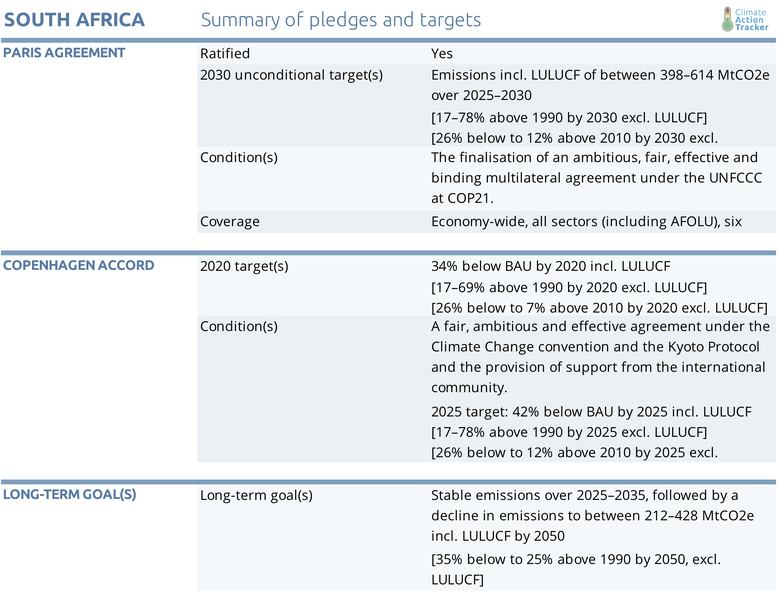Pledges And Targets
Summary Table

Paris Agreement targets
South Africa’s NDC, 2020 pledge and long-term target are consistent with its long-term goal to constrain its emissions to follow a peak-plateau-decline (PPD) trajectory. Based on this, South Africa’s emissions should peak between 2020 and 2025 (as targeted by the Copenhagen pledge and the NDC), plateau for approximately a decade and then decline in absolute terms, as shown in the red shaded range in the CAT’s South Africa graph in the overview section.
South Africa’s NDC targets an absolute emissions level in the range of 398–614 MtCO2e incl. LULUCF over the period 2025–2030 (Government of South Africa, 2016). Assuming LULUCF remains at the average level over 2000–2012 (-17 MtCO2e), this NDC translates to an emissions level of between 415–631 MtCO2e excluding LULUCF, equivalent to a 17–78% increase above 1990 levels excluding LULUCF.
South Africa’s NDC is “premised on the adoption of a comprehensive, ambitious, fair, effective and binding multilateral rules-based agreement under the UNFCCC at the 21st conference of the Parties (COP21)” (Government of South Africa, 2016). It also highlights that equity, economic and social development and poverty eradication are South Africa’s top priorities. To date, it is unknown how the government of South Africa interprets the Paris Agreement in terms of its ambition, fairness and effectiveness. As the NDC document does not specifically mention that the PPD trajectory range is an unconditional target, the CAT interprets the South African NDC as an unconditional target.
2020 pledge
Under the Copenhagen Accord, South Africa committed to reduce emissions below BAU by 34% in 2020, and by 42% in 2025, incl. LULUCF (Government of South Africa, 2010). The emissions level (excluding LULUCF) derived from South Africa’s pledge is 415–600 MtCO2e in 2020 and 415–631 MtCO2e by 2025. South Africa’s Copenhagen pledge is conditional on a fair, ambitious and effective agreement in the international climate change negotiations under the UNFCCC and the Kyoto Protocol and the provision of support from the international community.
Long-term goal
South Africa aims to reduce GHG emissions to 212–428 MtCO2e by 2050 (including LULUCF) (Department of Environmental Affairs, 2018a; Government of South Africa, 2010). Excluding LULUCF, this long-term target is equivalent to 229–445 MtCO2e. South Africa has further released a Draft Low Emission Development Strategy 2050 in December 2018 without specifying any additional quantified target for 2050 (Department of Environmental Affairs, 2018c). As of June 2019, South Africa has not submitted an official long-term low greenhouse gas emission development strategy to the UNFCCC in accordance with Art. 4 § 19 of the Paris Agreement.
Further analysis
Latest publications
Stay informed
Subscribe to our newsletter






